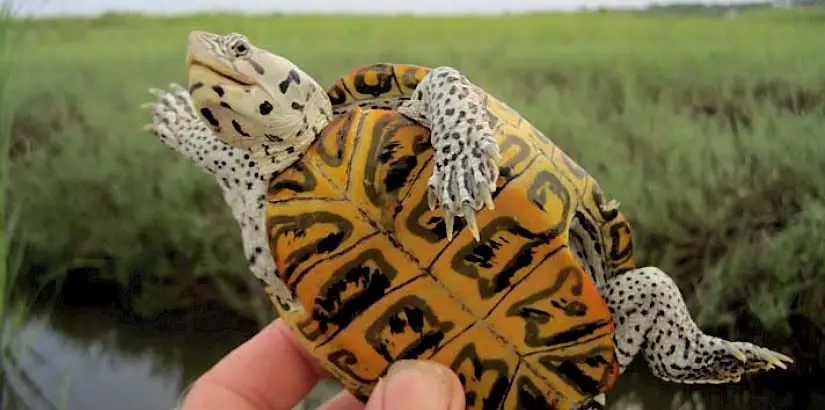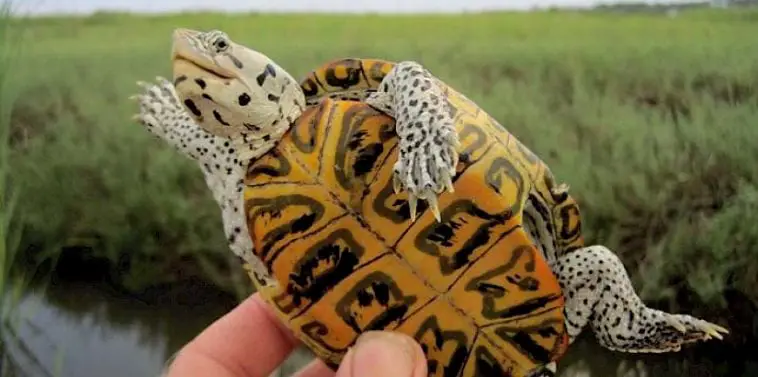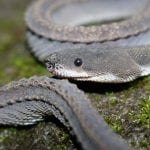Scientific Facts
| Common Name: | Diamondback Terrapin |
| Scientific Name: | Malaclemys Terrapin |
| Life Span: | Around 30 years |
| Mass: | Around 300 grams |
| Length: | 5 inches (males); 9 inches (females) |
| Clutch Size: | 4 to 22 eggs |
| Habitat: | Saltwater influenced habitats |
| Country of Origin: | United States |
Physical Description

Diamondback Terrapins are turtles that are medium in size. The males reach around 5 inches in length, while the female is significantly larger at around 9 inches in length. The skin color and carapace of terrapins is gray to white, with some patterns of black streaks and spots. Some also have back mustaches, as well as yellow blotches on the carapace scutes. There is also an orange tinge which may be featured on the marginal scutes of some Terrapins.
History and Origin
Terrapins are turtles that belong to the family Emydidae, with freshwater painted turtles, cooters, sliders and map turtles as their relatives. The closest subspecies of Terrapins are the map turtles from the genus Graptemys.
These turtles are considered as unique among the turtles of North America since they exclusively reside in saltwater-influenced habitats. The adult Terrapins are usually observed lurking in salt marsh creeks during low tide and are usually less noticeable during high tides. This is also the time when huge predators, including sharks, are most likely to invade their habitat.
Biologists studying about the lives of turtles suspect that Diamondback Terrapins hide during high tide in the mud of salt marsh flats and grasses, where they can also feed on periwinkle snails. Laying of eggs usually happen in grassy mudflats that are closer to the shore. The juveniles typically spend their early years while hiding in shallow water, under the mats of dead grasses, and mud.
Terrapins used to be very common, even used as a main source of food for protein by European settlers and Native Americans. From the mid-1800s to the early part of 190s, they were extensively hunted that there came the point when they almost faced extinction. Terrapin stew became very popular as a delicacy in the United States. For this reason, terrapins were exported to various countries in Europe.
In the latter part of the 19th century, about 400,000 lbs. of terrapin meat were harvested every year. Around 1920, their population significantly dwindled, allowing harvesters to get only 823 lbs. in a single singer. The use of terrapin meat for food also dropped in popularity because of a decrease in supply. This has further allowed the population of this species to recover slightly, and thus avoid extinction.
By 2001, a review on the status of reptiles in the state of New Jersey recommended that Northern Diamondback Terrapins be considered as a species of special concern. There has been evidence of decline as noted. In 2015 and 2016, drafted legislation pushed for the removal of terrapins from the list of games. This means that they can no longer be hunted and no hunting season is allowed for this species. Continuous protection is in place for these animals.
Habitat
Diamondback terrapins usually prefer saltwater for their habitats, including tidal flats, lagoons, coastlines, brackish channels, as well as estuarine regions. They also live nearby some reedy marshes and saltwater, though they still need fresh water for drinking.
Behavior
Since terrapins love spending most of their time in the water, it seems difficult to observe their personality and behavioral traits. They are timid creatures by nature. They easily flee when approached and threatened, escaping towards the water. These turtles have also been observed basking or walking on oyster beds and mudflats. They are also social animals who love basking in groups. It is not uncommon to see one terrapin on top of another.
It has been believed that terrapins hibernate during most of the colder months. As cold-blooded reptiles, they breathe in the air for their oxygen needs. This is because they do not have gills like other reptiles.
Types of Diamondback Terrapins
There is a huge variation in terms of the physical appearance of Diamondback Terrapin, leading to the identification of seven subspecies recognized historically along with the eastern coastal areas of the United States, from Massachusetts to Texas.
Northern Subspecies (M.t terrapin) and Carolina Subspecies (M. t. centrata)
The Northern Subspecies are usually found from Massachusetts to Virginia, while the Carolina Subspecies are found from North Carolina to Northern Florida. They are described generally as lacking knobs down the middle of the carapace, which makes them different from the other subspecies. Some females of the Carolina subspecies also seem to have bigger heads that the Northern Subspecies.
Florida East Coast Subspecies (M.t. Tequesta)
This subspecies usually lack the concentric circles that are usually found on carapace scutes.
Mangrove Subspecies (M.t. rhizophorarum)
This subspecies is usually found in the Florida Keys. They usually feature bumps on their dorsal keel. At the same time, the spots that are found on their neck look like streaks.
Ornate Subspecies (M.t. macrospilota)
They are typically found in Western Florida. They are often characterized by huge yellow or orange blotches found on the carapace in the middle of every scute.
Mississippi Subspecies (M.t. pileata)
This subspecies often show some brown carapace color.
Texas Subspecies (M.t. littoralis)
This subspecies is usually found from Louisiana to Eastern Texas). They usually feature a white head.
The difference in terms of appearance and color patterns of Diamondback Terrapins may be rampant in a single population. The farming of terrapins for food back in the earlier part of the 1900s, particularly in the Chesapeake Bay area of Virginia and Maryland, may have resulted in the mix of terrapins coming from different regions.
Population Status
The population of Diamondback Terrapins in the wild has considerably declined in several parts of their geographic range. As such, they have been listed as threatened, endangered, or regarded as species of special concern in certain states. As of the moment, the status of the Northern Diamondback Terrapin is unknown, though the species is under “apparently secure” in classification by both the states of Maryland and Virginia.
Terrapin populations also came to dangerously low levels back in the 20th century right after quite a long period of large-scale harvesting because of their meat. This period of commercial harvesting of terrapins ended around 2007.
Other specific factors that cause the declines in their populations include the destruction of nesting beaches and loss of salt marsh habitat as a result of waterfront development, boat strikes, road mortalities of nesting females, excessive predation of raccoons, as well as continued commercial harvesting in certain states.
Diamondback terrapins are usually attracted to similar baits that are used in luring blue crabs. When they are trapped in commercial gears for fishing or submerged crab pots, these air-breathing terrapins will drown eventually. The loss of these adult terrapins in crab pots is usually believed to be a primary cause of the decline in population in several parts of their range.
It has been noted that almost all death in crab pots may be prevented by installing these traps with turtle excluders or using the so-called “bycatch reduction devices,” otherwise known as BRDs. This modification may be simple, but it still allows bigger crabs to enter but keeps the adult terrapins out. Crabbing regulations in certain states require that all of the recreational crab pots should feature BRDs.
Predators
Female terrapins that are nesting are prone and vulnerable to predation, especially by raccoons. Hatchlings and eggs are often preyed upon by various animals, including crows, crabs, herons, gulls, muskrats, rats, foxes, mink and skunk. Terrapin eggs are also usually destroyed by the introduction of beach grass, as well as common reed. The survival rates of hatchlings and nests are extremely low as a result of flooding and high predation.
Threats and Solutions
It has been observed in certain locations that terrapin populations in creeks usually result in extirpation as a result of recreational crap pots being left unattended. This will drown the terrapins unnecessarily. In worse situations, there are ghost crap pots or those with rope lines that are either broken or forgotten on the surface. These lines capture and drown the terrapins.
Numerous studies are being conducted in order to find a way to solve these problems. In some areas, erecting some wildlife fencing helps, especially in areas surrounding the length of causeway. The only disadvantage of this endeavor is that it could be quite expensive. As an alternative, strategic locations were identified for the installation of shorter fences. This has led to the reduction of mortality of a greater number of Terrapins.
Even though human consumption of terrapins in different parts of North America has declined, there is still an increase in the demand of Terrapins in Asian markets in recent years.
Care in Captivity
Most Diamondback Terrapin is considered as docile. This means that they do not unnecessarily bite people when they are being held, though a few wills, depending on the threat they are facing. In particular, females, with their massive jaw muscles and head size, need to be especially handled with care.
In the wild, terrapins are naturally carnivorous, eating a wide variety of shellfish, including periwinkle snails. They also eat crustaceans, including blue crabs. Huge females feature strong jaws and can easily crack the shells even of bigger clams and snails. The smaller males, on the other hand, eat smaller prey. Hatching terrapins survive by eating small fiddler crabs.
In captivity, most terrapins are happy eating commercial turtle diets, like Reptomin. Among other favorites include dried brine shrimp, as well as frozen or thawed salad shrimp. They are also less likely to be ignored even by picky terrapin eaters. Cuttlebone and calcium blocks should also be fed to hatchling terrapins to enjoy.
Hatchlings are considered as the favored age class for any turtle hobbyist. They can be availed of from turtle breeders. They look really cute and attractive, with their huge, black eyes. Their colors are generally gray just above with some light-colored plastrons. Terrapins are also very active turtles which tend to grow quite fast. Terrapins caught from the wild can also be high strung, and are usually not recommended for captivity.
Aquarium Requirements
Hatchling terrapins in captivity require clear and clean water with a dependable filtration system. For their aquarium, a 20-gallon aquarium with 3 or 4 inches of water can serve as home to several Diamondback Terrapins. It should be noted, however, that terrapins can grow quite fast, which means that you may find yourself upgrading to a bigger enclosure soon enough.
A 40-gallon oval tub can house one adult female comfortably, or two adult males. While a single aquarium can serve as home to several hatchlings, it is recommended to overcrowd them. They may end up nipping each other’s tails, especially when they are hungry, or if one terrapin is bigger than the other. You may want to keep similar-sized terrapins together.
Poor quality of water is one of the leading causes of health issues among diamondback terrapins in captivity. They also need to have circulating water. With this, you can use submersible pumps, including a Fluval 3 for a 20-gallon aquarium. A Fluval 4 is also good for the 40-gallon tub. The water should be flowing and clean inside the enclosure, with a pH level that is slightly acidic to neutral, between the 6.8 to 7.0 range.
Keep in mind that terrapins love open water, and actively swims as well. Still, they need places where they can hang out. You may want to add some plastic aquarium plants as it usually works well in providing areas for them to rest and grasp onto.
Diamondback terrapins have the tendency to be messy eaters. As such, it is recommended to feed them in separate containers which can easily be removed and cleaned right after use. This will lessen the need to clean the filter in the enclosures.
Another must is a basking site where your pet can merge from the water completely and dry off. Placing floating basking sites will work well also for hatchlings, though bigger, adult terrapins need a solidly anchored site for basking, including a ramped board or a log.
Lighting and Temperature
A full-spectrum UV bulb, as well as a 50 to 75-watt basking spotlight, can be used to light the basking site. This is effective in maintaining the temperature in the mid-range of 80 degrees Fahrenheit. In the wild, it is quite rare to observe terrapins basking because they are generally skittish and secretive. They usually bask in big numbers on mudflats in mostly hidden sections of tidal creeks.
The temperature of the water needs to stay in the range of 76 to 78 degrees. For hatchlings, this temperature may be accomplished by using an underwater glass tube heater. For bigger terrapins, an infrared spotlight with a timer for nighttime use may be used in maintaining appropriate temperatures. Make sure to regularly monitor the temperature of your setup using a thermometer.
Water Requirements
Terrapins love drinking fresh water when provided with a good source. In order to mimic optimal wild conditions, periodic soakings of terrapins in freshwater may be used for drinking purposes. This can be done during feeding by using a separate container. Periodic soakings can also go together with a 25-percent seawater concentration inside their home enclosure.
Mating and Reproduction
Diamondback terrapins mate in spring, laying 4 to 22 eggs by the early summer. These eggs hatch towards the end of the season, or early fall. The incubation period usually lasts from 60 to 85 days. The warmer the soil, the faster the eggs will hatch.
The sex of the hatchlings is often determined by the soil temperature. The warmer the temperature of the soil is, the more female turtles are expected to be produced.
Life Cycle
In general, Diamondback Terrapins are ectothermic, or cold-blooded. They usually hibernate at wintertime, burying themselves at either the bottom or in the muddy banks of creeks, open water bays, and ditches. This is why they are always seen with some mud covering them.
The sexing of terrapins can be identified using the temperature-dependent sex determination (TSD). With this, it is understood that only about 1-3% of the laid eggs actually produce a hatchling. The success rates of the young turtles actually reaching adulthood is low.
The hatchlings overwinter in nests sometimes. This means that those laid in the latter part of the year emerge the next year, usually in April. After hatching, they head for vegetation immediately, thus helping in providing protection and cover form predators such as crows and gulls.
From time to time, hatchlings wind up in storm drains. In these places, many terrapins die because they cannot escape. The males usually reach maturity at 5 to 8 years, or when they are around 3 to 3.5” in terms of length. The females, however, do not reach sexual maturity until about 9 to 10 years of age, or when they are 6.5” in length, with a weight of 2.3 pounds.
Conservation Status
Diamondback Terrapins have a reputation for being exploited by humans. For several decades now, they were being harvested for their meat and food, as they were often used in turtle soup. Even though terrapins are no longer being harvested in many places, they still accidentally enter crab traps and end up drowning. On top of that, degradation of nesting beaches and salt marshes, along with as road mortality among nesting females also affect this species. Though terrapins have greatly declined in some parts of Florida, they are still common in some regions and are even listed as non-threatened species, even though it has been regarded as a species for status review for more than a decade now.
Interesting Facts about Diamondback Terrapin
Here are some interesting facts about Diamondback Terrapin:
- Female terrapins are observed in mating with multiple males. They also have the capacity to store the sperm for years, and afterwards producing a clutch of eggs coming from different fathers.
- Terrapins are considered as a delicacy, mostly used on turtle soup. At one point, this went on so badly that they were even driven to the edge of extinction. Since it was acknowledged, this practice has been stopped.
- Diamondback Terrapins are the only turtle variety that lives in brackish water.
- The name “terrapin” comes from the word “torope.” It was first used by the European settlers of North America and is used in describing these species.
Where to Get One?
You can get a Diamondback Terrapin from a reptile store, or from someone who is breeding them for the pet trade.
How to Care for Diamondback Terrapin as a Pet
Terrapins usually need brackish, or slightly salty water while in captivity. This is to mimic their environment in the wild. Some owners of Diamondbacks in captivity have observed some success in keeping their turtles happy in freshwater. Some, however, observe some health issues with their pets in this kind of setup, and as a result, decide to switch to brackish water.
Since Terrapins are considered as aquatic turtles, they need a tank filled with brackish water. It should be deep enough for the pets to dive and swim comfortably. They also require a flat, wide place to get out of the water and spend some time on dry land. A 75 gallon or even a larger tank is good enough, along with a huge, flat rock, or another surface for basking.
Many owners opt for a fish tank for their pets. However, any huge waterproof container will also do, given that they cannot easily climb out, and other objects or pets cannot fall in or climb into.
FAQ Section
How long do Diamondback Terrapins live?
These turtles may live up to 30 years, or even longer in the wild. This means that for those who want to keep them as pets, care is required during the entire life of this turtle.
Is it possible to keep Diamondback Terrapins as a pet?
Diamondback Terrapins are considered as among the most unique species of turtles in North America. As such, they are in need of conservation. Even though these turtles are not protected federally, they are still being protected across several states. This means that keeping them as pets is either illegal or only allowed with a permit.
How do you take care of a Diamondback Terrapin?
Adults, as well as captive-born hatchlings, may be kept in freshwater. When they start to develop shell rot, it is an indication that they need to be moved back to brackish water. In terms of diet, juveniles and hatchlings need to be fed a combination of commercially available foods, and small live food for treats.
How long can Diamondback Terrapins stay out of water?
Terrapins are not designed to have gills. This means that they can only stay underwater for up to 3 or 4 hours at the most, especially during summertime temperatures.
Do Terrapins bite?
Terrapins are known to be aggressive. Their bite can really hurt. After handling your Diamondback Terrapin, it is recommended to wash your hands using soap and water.
Are Diamondback Terrapins good pets?
Terrapins are considered among the most popular breeds of turtles that are kept as pets. Proper care of terrapins involves maintaining a friendly and clean environment, regular visits to the veterinarian, and ensuring a healthy diet for your pet.
Do Diamondback Terrapins bask?
The coloration of the shell greatly varies with Terrapins. They usually range from black to brown or pale gray. Even though terrapins stay mainly in the water, they may also be observed basking along some marsh creek banks.
What do Diamondback Terrapins eat?
Diamondback Terrapins are adapted well to eating preys that are hard-shelled, including crabs, aquatic snails, as well as small bivalves like clams and blue mussels. The female terrapins feature broad plates on their jaws which are useful in crushing prey. Other food options include fish, carrion, insects, and marine worms.
What do baby Terrapins eat?
In the wild, baby Terrapins mainly survive on live food. As they are carnivores, they also eat tadpoles, worms, insects, worms, and anything similar to these foods in terms of size. They also catch their food as they swim about.
Do Diamondback Terrapins like deep water?
Diamondback Turtles are freshwater turtles. They are cold-blooded, semi-aquatic reptiles which only means that they really need access to deep water where they can swim. At the same time, they also need rocks and lands where they can bask under the sun during the day.
Where do Diamondback Terrapins lay their eggs?
Diamondback Terrapins mate in the water, typically at nighttime, around the month of May. After they mate, the females surface onto beaches, digging a shallow nest in the sand. After doing so, they start laying up to 10 to 15 eggs that are pinkish-white in color.
What kind of turtle is a Terrapin?
The exact term used of a specific type of turtle may vary depending on their place of habitat. Diamondback Terrapins are turtles that spend their time both in swampy, brackish water and on land. The term “terrapin” hails from an Algonquian Indian word which means “little turtle.”
Do Terrapins need heat?
Diamondback Terrapins have specific needs in captivity. For instance, they usually need warm heated water where they can swim in, and an area of dry land where they can easily drag themselves out. They may even prefer a basking lamp where they can lie under, allowing them to completely dry out and raise the temperature of their body.
Can Diamondback Terrapins drown?
Absolutely, yes. Even though turtles, in general, can stay underwater for longer periods of time, they are not designed to breathe underwater, as they do not have gills. They do drown depending on the circumstances.
Do Terrapins carry salmonella?
In general, turtles carry Salmonella bacteria on their shell and outer skin surfaces. As such, people can also get infected with this virus when they come in contact with these turtles.
How fast do Terrapins grow?
Terrapins usually take around three to eight years to completely reach maturity. Female terrapins are bigger than the males. It is very important to understand the speed at which these turtles grow before even deciding to have them as pets.



